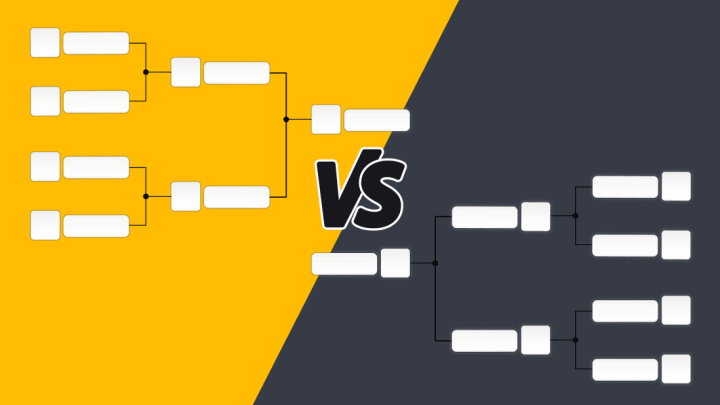The modern chess set is called the Staunton set, for Howard Staunton, the English chess master who popularized its use in the 19th century. But Staunton's most lasting contribution to sports might be in one that wasn’t even invented by the time he died in 1874.
The NCAA Men’s Basketball Tournament is upon us, and if you’ve ever filled out a tournament bracket—for fun or profit—you have Staunton to thank.
For a chess tournament in 1851, Staunton had 16 players draw lots for random pairings, called brackets because they resembled the punctuation marks of the same name. The eight winners would then draw lots for pairings, and the four winners from that round would do the same, leaving two finalists. The idea, Staunton said, was “to bring the two best players in the Tournament into collision for the chief prize.” The reality, however, fell short: Random drawing after every round led to complaints that some players had easier matches. As a result, chess tournaments shifted to a round-robin format.
Brackets were used again—and have been ever since—for the Wimbledon tennis tournament in 1877, and they found a home in college basketball in 1939, when the National Association of Basketball Coaches had an eight-team tournament. The University of Oregon beat The Ohio State in what is regarded as the first NCAA Tournament.
For decades, the NCAA Tournament looked vastly different than it does today. Rules prohibited more than one team per conference in the tournament, and the field was littered with byes (allowing a team to automatically advance to the next round, regardless of play) and even a consolation game for third place (which was held until 1981). The tournament also dueled for supremacy with the National Invitation Tournament, with schools even turning down NCAA Tournament bids in favor of the NIT.
But two events in the 1970s changed the college basketball landscape. The first bracket pool started in 1977 at Jody's Club Forest, a bar in Staten Island, for $10 a pop—winner take all. Two years later, a network emerged in Connecticut, as part of a new technology called cable television. The Entertainment Sports and Programming network was originally launched to broadcast University of Connecticut athletics and state high school championships, but suddenly found itself struggling to fill hours of airtime.
NBC had the NCAA championship game, but ESP (the N would come later) wanted to air the other games, which was a surprise even to then-NCAA chairman Walter Byers, who said, “You mean if Weber State and Lamar Tech are playing, you’re going to televise it?”
And it was that fateful decision that set us down the path to what we now know as March Madness. Shortly after ESPN signed the deal with the NCAA—before the cable network even took to the airwaves in 1979—Larry Bird and Indiana State matched up with Magic Johnson and Michigan State in the championship game, sparking interest nationwide. In 1985, the tournament expanded to include 64 teams but with no byes, leading to a weekend of wall-to-wall college basketball (the field expanded to 65 in 2001, offering a play-in game for one last team, and then to 68 a decade later, leading to the “First Four” games in Dayton). The field is divided into four regions, each with 16 teams.
You could find brackets to fill out in practically any college dorm room, bar, or workplace—or even in the local newspaper. It’s easy to do, but hard to master. The 68-team field means that there are more than 9 quintillion potential outcomes from the start of the tournament to One Shining Moment at the end. But DePaul University professor Jeff Bergen calculated more precise odds, taking into account informed decisions, of a perfect bracket: 1 in 128 billion.
Nobody’s done it yet.
